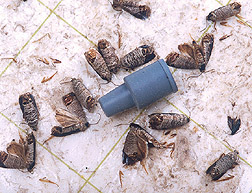This page has been archived and is being provided for reference purposes only. The page is no longer being updated, and therefore, links on the page may be invalid.
| Read the magazine story to find out more. |
|
|
Enhanced Lure Proves Irresistible to Orchard Pest
By Jan SuszkiwJuly 5, 2013
New lures that entice codling moths with the scent of food and a possible mate are helping tree fruit growers better monitor the orchard pest and control it with carefully timed insecticide applications.
Codling moths, as larvae, are major pests of apples, pears and walnuts. Historically, growers have sprayed their orchards with insecticide to prevent the pinkish-white, 3/4-inch-long larvae from holing up inside the fruit to feed, damaging it and ruining its marketability both in the United States and abroad.
Lures baited with synthetic versions of the adult female moth's chemical sex attractant, or sex pheromone, have helped growers refine their timing of insecticide and reduce the amount applied. As part of research to improve the technology further, a team of U.S. Department of Agriculture (USDA) and collaborating scientists has identified and synthesized new compounds to use with the sex pheromone. Among these are pear ester and acetic acid.
Pear ester is the characteristic aroma of ripe pears, and acetic acid is what makes vinegar tangy, notes Alan Knight. He investigated the attractants together with two other scientists with USDA's Agricultural Research Service (ARS)—Peter Landolt and Douglas Light—and outside collaborators. Knight and Landolt work at the ARS Yakima Agricultural Research Laboratory in Wapato, Wash. Light is at the ARS Western Regional Research Center in Albany, Calif.
Pear ester alone is a potent attractant for both sexes of codling moth. Adding acetic acid significantly increases the number caught. However, the team found that the most powerful lure resulted from combining pear ester, sex pheromone and acetic acid. The team's studies indicated that the combined lure can capture eight to 10 times more female moths than using the pear ester-pheromone combination alone.
Using lure-based monitoring tools, the researchers also developed action thresholds based on both female and total moth catches that enabled growers to reduce their pesticide applications by 30 to 70 percent. Orchard-scale trials are under way to find out whether combining the pear ester-pheromone lures with acetic acid can effectively be used to monitor apple leafrollers, which are important secondary pests.
Read more about this research in the July 2013 issue of Agricultural Research magazine.
ARS is USDA's chief intramural scientific research agency, and this research supports the USDA priority of promoting international food security.

